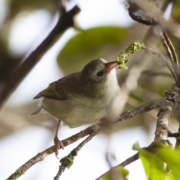Thinking Like an ‘Akeke‘e: The Nest Searching Process
by Ke Coco Deng
5/30/2025
With the number of ‘akeke‘e steadily decreasing due to avian malaria, it is always exciting to see them in the wild. ‘Akeke‘e is a forest bird endemic to Kaua‘i. Even in their core habitat in the Alaka‘i Wilderness Preserve, ‘akeke‘e can be challenging to find as they forage high in the canopy on the buds of ʻōhiʻa. We treasure the time we spend living and working with them in the wild. One of our objectives this season is ‘akeke‘e nest searching: combing through miles of dense rainforest to find the nests of this increasingly elusive bird. Every nest is a valuable data point that grants us more knowledge about the life history of this critically endangered species.
To find an ‘akeke‘e nest, one must learn to think like an ‘akeke‘e. Nest searching requires a deep understanding of bird behavior. During the breeding season, ‘akeke‘e like to call and sing close to their nests to establish their territories. Our field technicians monitor ‘akeke‘e activity closely throughout the season, making note of when and where they are seen and heard so we can determine where they are likely to be nesting. This season, we have observed ‘akeke‘e singing, calling, and foraging over our Halepa‘akai field camp. Our crew have spent several weeks searching for nests in this area.
In April, field technician Ke Coco Deng discovered an ‘akeke‘e nest close to Halepa‘akai camp. She followed begging calls to a moss-lined nest with chicks, high up in the branches of an ʻōhiʻa lehua. All of our nests receive unique names to help us identify them. She named this nest “WARD,” as in protection, to lend good fortune to the nest and to the future of ‘akeke‘e. The name also refers to how we ward off threats to our forest birds through conservation so that they can continue to resist extinction. We made detailed observations about the chick rearing behavior of ‘akeke‘e at this nest, which may be important for future research and conservation.
A few weeks passed before our next nest update. We heard bird calls over Halepa‘akai camp and looked up to see an ‘akeke‘e family—two adults and two fledglings! The fledglings were making beginner attempts at foraging, slowly prying apart the buds of an ʻōhiʻa ha in search of insects. Though the bills of ‘akeke‘e have adapted to feed from insects inside ʻōhiʻa buds, practice makes perfect! Soon, the fledglings will be masters of foraging like their parents, finding insects in seconds. As ‘akeke‘e numbers continue to decline, it is heartening to see young birds joining the population. To help protect these vulnerable fledglings from mosquito-borne diseases like avian malaria, mosquito control efforts are currently being deployed on Kaua‘i. We hope to share the Alaka‘i with these birds for some time yet.

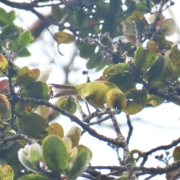


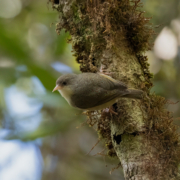
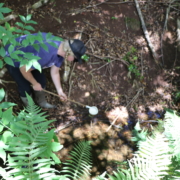 Daniel Dennison, State of Hawaii
Daniel Dennison, State of Hawaii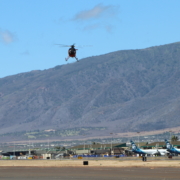

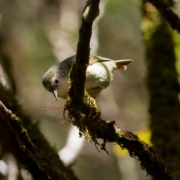 Robby Kohley
Robby Kohley